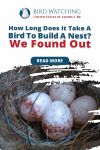
What’s This Post About?
The sight of a bird building a nest is quite breathtaking. When spring comes around, the birds worldwide start constructing cozy nests in preparation for either their courtship processes or the arrival of their offspring.
If you spend some time outdoors during March and April, you will surely see many nests popping up around your yard.
Even though birds only devote a short period constructing their nests, they manage to do so in a way that is entirely unique to their species. They can build incredibly intricate structures with just their beaks. However, most people are often found wondering, how long does a bird take to build a nest?
A bird’s nest might take anywhere from two days to two weeks to complete. Keep in mind that several factors can affect how long it takes a bird to construct a nest. Everything matters, from the materials utilized to the specific structure to the weather conditions.

How Long Does It Take To Build A Nest?

Nests provide a secure environment for the development of eggs and young chicks. Since each bird type has its own distinct nest design, bird nests are highly varied. It usually takes two weeks or less to build a nest. This, however, will depend on the birds’ experience, help received, and weather conditions.
Some birds don’t build nests, preferring to deposit their eggs in a hole in the ground. On the contrary, other birds use natural elements like vegetation, twigs, dirt, moss, feathers, and artificial items such as papers, plastics, and thread to build their nests.
Nests may be found virtually anywhere: on the ground, in treetops, in holes, on cliff edges, and in buildings. However, there are a few variables that can impact the time it takes to build a nest.
1. Complexity

The type of the nest is of most importance. It decides the time and the effort the birds have to put in to build their nests. However, remember that this alone is not a factor, and other variables will contribute quite significantly.
Consider the female chipping sparrow for this. The female constructs the nest while the male chipping sparrow defends it from threats and rival males. Chipping sparrows make their homes in just three to four days.
Even though the female is building the nest alone, their requirement is relatively minimal. The end product is a flimsy cup with animal hair and delicate plant matter containing roots and dried vegetation.
2. Weather
Compared to a nest built in the warmer months, a bird will create a more sheltered nest in the winter. At the same time, it would provide better insulation for incubation during chilly temperatures.
An adult’s energy usage throughout building and incubating would also be affected by the weather. Not only will the bird require more resources, but it will also be slowed by the harsher conditions winters bring. Thus additional work, energy expended, lesser stamina all suggest the same thing - Birds in more warm climates can construct nests faster.
Winter nest-building includes, for instance, the female Baltimore Oriole that chooses a nest site after the male has secured a region. Construction takes up to 15 days and is divided into three stages: constructing the outer basket, creating the interior cup, and covering the cup.
However, bear in mind that not all winter nests have to take longer. Consider the goldfinches, for instance - although male and female goldfinches work together to pick a nesting location, the female does most of the work. Despite doing this work solo and during winter, it takes her just about a week to complete her masterpiece.
3. Intention
The time it takes to build a nest also depends on the intention behind it. For example, some nests are part of a courtship process and are made by the male to lure the female. Most nests, however, are built after courting with the purpose of breeding.
For example, a male bower bird does not create a nest for its eggs but instead constructs a tent-like framework out of twigs and other materials. Once the courtship and breeding processes are done, the female builds the actual nest for the eggs and nestlings near the male’s construction.
You might think that the nests that are built with the purpose of courting may not take that much time. It is quite the opposite. These birds’ nests are an essential part of getting a female to mate with them.
When it comes to attracting a mate, a male nest-building bird isn’t joking. He might work on his invention for weeks. Males with the most acceptable abilities have a comparative advantage in species where males create or start nests. To prospective mates, a male’s ability to build a nest displays his skills and strength.
4. New Nest or Restored Nest

The time taken to build a nest can also depend on whether the birds are reusing an old nest and restoring it or building one from scratch. Based on whether it is repairing an existing structure or constructing a new one, a bowerbird may spend anywhere from a week to 2 months setting its bower in shape.
DID YOU KNOW?
Male satin bowerbirds have constructed some bowers that have lasted over 30 years.
5. Experience
The time taken for birds to build a nest can also depend on experience. As they grow older and go through the nest building and breeding process, they will gain skills and finish fast—for instance, Village weavers who make well-shaped stick nests improve their nest-building skills through practice.
Similarly, nests built by young males are not as well constructed as those created by older males.
DID YOU KNOW?
Weaver birds kept in solitude build nests similar to those of their species. Weaver's nest construction appears to be a combination of instincts and experience.
Birds with experience also know what material works best. Researchers gave some finches flexible and rigid strings to build nests with. After constructing a nest with either string type, the birds showed an increased preference for stiff string.
With practice, they learned that fewer pieces of stiff string could be used to create a covered nest. This suggested that with time they realized that stiff string was the more appropriate construction material.
6. Shared Responsibility

Naturally, species, where both parents work to build a nest will be more efficient than those where either one is responsible. For example, a male robin provides his female partner nesting supplies to construct their nest. It takes 2 to 6 days for the female to make a cup-like nest using mud.
What Types of Nests Exist?
Birds’ nests range from minor scrapes on the ground to intricately woven nests. They are temporary but precisely constructed homes to nurture the young.
Since there are many different bird species, there are also many different kinds of bird nest designs. Combined with other factors, the type of nest will also affect how long it takes for birds to build their nests.
1. Long-Lasting Nests

Some birds will build a nest and use it every year, enlarging it or doing periodic upkeep. The bald eagle, for example, is known for being the best nest constructor in the world. An eagle’s nest measuring ten feet wide, twenty feet across, and weighing roughly 4400 pounds was discovered in Florida.
2. Small Nests

To no one’s surprise, Hummingbirds, our tiniest birds, construct the tiniest nests. Hummingbirds use plants, soft materials, and spider webs to build nests on tree branches. During building, these lovely little birds may deposit eggs and continue to make the sidewalls during incubation.
DID YOU KNOW?
Hummingbirds often deposit a pair of eggs the size of black beans within a quarter-sized nest. The nest grows as the infants develop, keeping things snug and comfortable.
3. Elaborate Nests

Orioles distinctive suspended nests drop from the furthest limbs of the trees. During the mating season, the nests are virtually impossible to see among the bare winter branches and nearly as difficult to spot when shrouded by leaves. Their colossal nests may reach a height of two feet.
4. No Effort Nests
Some birds get away with scarcely constructing a nest at all. This isn’t to say that they’re sluggish or careless when it comes to building nests. Instead, they let nature help them build their nests by forging or assisting them. Beach Nesting Birds, for example, deposit their eggs in deep protrusions in the sand.
Their success can be attributed to their cryptic concealment, and their eggs are spotted to fit the sandy surroundings. To supplement the cover, sometimes all that is necessary is to surround the nest with sand or seashells.
5. Floating Nests

Some water birds, such as ducks, build their nests on highland meadows distant from the water. Others, such as loons, and gallinules, build their nests just on the water’s surface. The birds make floating plank nests out of reeds, various aquatic plants, or mud. They secure the nests to emerging foliage to keep them hidden and prevent them from floating away.
6. Nests in Cavities

Using an existing hole to construct a nest is a less time-consuming option. Many birds, such as tits and owls, use existing holes in trees as a fully prepared nesting site for their offspring.
Others, such as starlings and house sparrows, have learned to construct their nests in holes in rooftops. It’s still necessary to line the nest once they’ve picked it, but it’s a lot quicker. Filling a hollow cavity with grass is a straightforward operation that looks messy but gets the job done for sparrows.
How Do Birds Build A Nest?

The construction process frequently begins in an uncontrolled manner. The birds first collect all the nesting resources. After the material has been collected, the birds come back and tidy things. Then, they mold and build the structure that suits them using the collected material.
Birds twist and interweave the fibers of their nest together using their sharp beaks. In addition, birds can use spider webs or mud to reinforce their nests, transforming a jumble of sticks into a sturdy dwelling. Many species even utilize their own saliva as a kind of ‘glue’ for their nests.
Each form of the nest is built by a different bird species. Birds don’t need to be shown how to make nests since they already know. They do, however, get better at building nests with practice. Different birds construct their nests in various ways.
Do All Birds Build Their Nests?
Although each species has its own distinct nest design, bird nests are highly varied. In fact, not all birds construct nests. Some dump their eggs into other birds’ nests, some steal other nests, while some might not even build nests at all. They prefer laying their eggs in a hole in the ground.
Stealing Nests
Some birds do not build their own spot but instead capture the nests made by other smaller birds. For example, sparrows have been observed to rob robins and bluebirds of their nests. They will murder other nestlings, smash eggs, and even establish nests on top of current nests to do this.
Brood Parasites
Brood parasites are creatures that rear their eggs with the help of others. The brood parasite will coerce its host, whether it is of the same breed or not, into raising its offspring as if they were their children. These parasites do this to escape parental duties.
An excellent example of a bird brood parasite is the caramel-colored cowbird of North America. Even though it is a tiny obligate brood parasite, it is pretty aggressive and dominating. It will deposit an egg in the nest of another bird.
No Nests

Many birds do not construct nests, but they do choose where to lay their eggs. Nightjars promptly deposit their two eggs on the ground. Short-eared Owls just lie on trodden plants. Plovers lay eggs in a small scrape on the ground, depending on their eggs’ cryptic coloration to shield them from predators.
How Can You Help The Birds?
All of this nesting takes time and effort on the part of the birds. They can become focused on egg-laying if they don’t have to put as much effort into obtaining nest ingredients. You can help the birds by making their nesting territory more bird-friendly and putting out nesting materials.
Here are a few things that you can do to help nesting birds and perhaps accelerate the nesting process:
Nesting Material

Birds will gather natural fibers and plant matter if you leave them out. Put these in a nearby bush or a suspended plant pot to aid the birds in acquiring nesting supplies. Since most birds prefer twigs, branches, grass, and feathers, these are the materials you should put out.
However, if you know what kind of birds specifically nest in your yard, you can be customized with your help. For example:
- House sparrows like to gather nesting material within a few meters of their nest. They build their nests out of hay, weeds, and other natural elements.
- Starlings eat freshly pruned green leaves from bushes in the spring. They may also utilize moss from your yard as well as wool.
- House martins and blackbirds use mud to build their nests. A tiny, moist, muddy spot in your yard, such as a muddy puddle or the side of a pond, may make building a nest simpler for them.
WARNING!
Do not put out pet hair or human hair as they may be contaminated with chemicals. Human hair can also harm the birds because of the possibility of getting tangled in them.
Healthy Habitat

Birds spend a lot of time and energy looking for food and water sources during the nesting process. Moreso, either one or both the parents also have to be on the lookout for potential predators and threats. In the midst of all of this, you can also help the birds remain focused on nest building by creating a healthy habitat for them in your yard by following these tips:
- Put out bird feeders to supply them with adequate food.
- Build a birdbath so they can drink and bathe in it.
- Provide nesting or birdhouses to give them better housing options.
- Keep your pets away from the yard during nesting season.

Keep Reading!
There are thousands of distinct bird species, each with its own method of building a nest. These birds can take from three days up to 2 weeks to build a nest. However, multiple factors can come into play apart from the design and complexity of the nest, like climate, old nests, nest construction, and if the nest is for courting or breeding.
If you come across any bird’s nest in your yard, leave it alone and keep an eye on the fledgling birds from afar. Now that you know a little about nests in general, read this comprehensive post to learn about bluebird nests – where to find them, what they look like, and more.
Bluebird Nests: Where To Find Them, What They Look Like, & More!
Are you trying to locate the famous bluebird? Try locating open grasslands and decaying trees – it's their favorite spot!

By David A. Swanson
Bird Watching USA
My name is David and I'm the the founder of Bird Watching USA! I started Bird Watching with My father-in-law many years ago, and I've become an addict to watching these beautiful creatures. I've learnt so much over about bird watching over the years that I want to share with the world everything I know about them!

David A. Swanson
Bird Watching USA
My name is David and I'm the the founder of Bird Watching USA! I started Bird Watching with My father-in-law many years ago, and I've become an addict to watching these beautiful creatures. I've learnt so much over about bird watching over the years that I want to share with the world everything I know about them!








